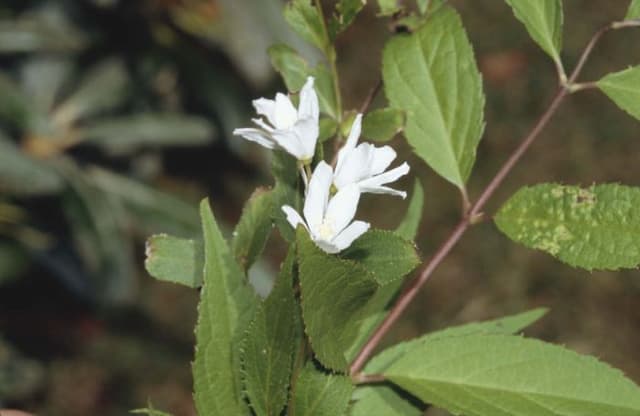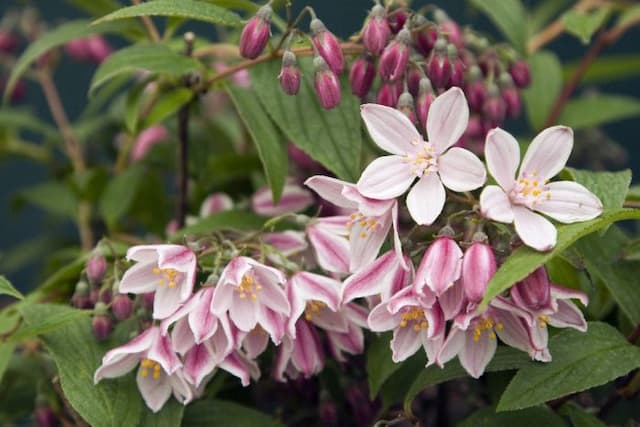Wedding Gown Hydrangea Hydrangea macrophylla 'Wedding Gown' (PBR) (Double Delights Series) (L/d)

ABOUT
The Hydrangea macrophylla 'Wedding Gown', also part of the Double Delights Series, is known for its distinctive and elegant flowers, which are a standout feature of the plant. The blooms are double in form, giving a very full and fluffy appearance akin to a bridal bouquet, which likely inspired its name. Flowers emerge as a creamy white hue with a tinge of pale green in their early stages. As they mature, they may develop a richer, more opulent white color that remains crisp and fresh-looking. The blossoms form large, rounded clusters, known as mopheads, that can cover the plant, creating a stunning visual display. The exceptional contrast provided by the luscious dark green leaves makes the white flowers even more pronounced. These leaves have somewhat of an oval shape with pointed tips and are typically glossy, adding to the ornamental appeal of the plant. Another striking aspect of the 'Wedding Gown' hydrangea is the manner in which the flowers open. They start at the base of the cluster and bloom progressively towards the top, which can prolong the ornamental display since not all flowers come into bloom at once. The plant maintains its presence through numerous seasons, flourishing with these extraordinary blooms primarily in the spring and summer. Overall, the 'Wedding Gown' hydrangea can be described as a lush, floriferous shrub with striking white double flowers and rich green foliage that brings an elegant and romantic flair to gardens and landscape designs. Its blossoms are often associated with purity and grace, reminiscent of a bride on her wedding day, hence its evocative name.
About this plant
 Names
NamesFamily
Hydrangeaceae.
Synonyms
Wedding Gown Hydrangea, Double Delights Wedding Gown Hydrangea, Lacecap Hydrangea Wedding Gown, Double Delights Bridal Hydrangea.
Common names
Hydrangea macrophylla 'Dancing Snow', Hydrangea macrophylla 'Hanabi'.
 Toxicity
ToxicityTo humans
Hydrangeas, including the variety known as 'Wedding Gown', contain compounds that can be toxic to humans if ingested. The plant contains cyanogenic glycosides, which can release cyanide when chewed or digested. Symptoms of poisoning can include stomach upset, vomiting, and diarrhea. In more severe cases, ingestion can lead to symptoms such as dizziness, rapid heart rate, and convulsions. It is generally recommended to avoid eating any parts of hydrangeas due to the risk of cyanide poisoning.
To pets
Hydrangeas, including the 'Wedding Gown' variety, are toxic to pets if ingested. The plant contains cyanogenic glycosides, which can convert into cyanide within the pet's body. Symptoms of hydrangea poisoning in pets include gastrointestinal upset, such as vomiting and diarrhea, lethargy, and depression. In severe cases, pets might also experience more serious symptoms such as difficulty breathing, increased heart rate, seizures, or coma. Pets, especially dogs and cats, should be kept away from hydrangeas to prevent accidental ingestion and potential cyanide poisoning.
 Characteristics
CharacteristicsLife cycle
Perennials
Foliage type
Deciduous
Color of leaves
Green
Flower color
White
Height
3-5 feet (0.91-1.52 meters)
Spread
3-5 feet (0.91-1.52 meters)
Plant type
Shrub
Hardiness zones
5
Native area
Japan
Benefits
 General Benefits
General Benefits- Aesthetic Appeal: The Hydrangea macrophylla 'Wedding Gown' features beautiful double white blooms that add elegance to any landscape or garden.
- Seasonal Interest: This variety of hydrangea offers multi-season interest with flowers in spring and summer and sometimes autumn foliage changes.
- Low Maintenance: Hydrangeas generally require minimal care once established, making them suitable for gardeners of all skill levels.
- Attracts Pollinators: The large blooms of the 'Wedding Gown' hydrangea attract bees and butterflies, promoting biodiversity.
- Versatile Landscaping: This hydrangea can be used in a variety of landscaping designs, including borders, foundation plantings, and as a specimen plant.
- Adaptable to Containers: The 'Wedding Gown' hydrangea can be grown in containers, making it a good choice for patios, balconies, and small gardens.
- Color Change with pH: The bloom color can vary from pink to blue depending on the soil pH, allowing for interesting customization in the garden.
 Medical Properties
Medical PropertiesThis plant is not used for medical purposes.
 Air-purifying Qualities
Air-purifying QualitiesThis plant is not specifically known for air purifying qualities.
 Other Uses
Other Uses- Photography Prop: Hydrangea blooms, with their lush and full appearance, are favored as elegant, natural backdrops for close-up photography sessions.
- Gift Plant: A potted Hydrangea can make an excellent living gift to celebrate weddings, anniversaries, or as a symbol of heartfelt emotions.
- Artistic Inspiration: The delicate form and variety of colors of Hydrangea blooms provide inspiration for artists in creating paintings or textile designs.
- Dried Flower Arrangements: The flowers of Hydrangea can be dried and preserved, maintaining their shape and color for use in long-lasting floral displays.
- Educational Tool: In botany and horticulture education, Hydrangeas can demonstrate how soil pH influences flower color, with the blooms changing from pink to blue in varying soil conditions.
- Fabric Dye: Historically, some species of Hydrangeas were used as a natural dye source, creating a range of colors for textiles based on the pH level during processing.
- Event Decorating: Their voluminous blooms are often used to create dramatic and opulent decorations for events such as garden parties or high teas.
- Garden Structures: With proper training and support, Hydrangeas can be shaped into living garden structures, such as arches or garden partitions.
- Cultural Symbolism: Hydrangeas are associated with different meanings in various cultures, such as gratitude in Japan, and can be used in cultural festivals or traditions.
- Ice Cream Garnish: Some upscale desserts and ice creams use crystallized Hydrangea petals as an exotic and decorative edible garnish.
Interesting Facts
 Feng Shui
Feng ShuiHydrangea is not used in Feng Shui practice.
 Zodiac Sign Compitability
Zodiac Sign CompitabilityHydrangea is not used in astrology practice.
 Plant Symbolism
Plant Symbolism- Heartfelt Emotions: Hydrangeas commonly symbolize deep and heartfelt emotions, whether they are of love, gratitude or understanding, making them perfect for weddings and other significant celebrations.
- Gratitude: With their lush blooms, Hydrangeas are often given as expressions of thanks, representing appreciation and heartfelt sincerity.
- Grace and Beauty: The elegant blooms of the Wedding Gown Hydrangea convey a message of grace, beauty, and abundance, fitting for their use in bridal occasions or as a gift.
- Perseverance: Hydrangeas can also symbolize perseverance, as they require meticulous care and attention to thrive, reflecting the effort needed in relationships or personal growth.
- Understanding: The multi-layered blooms of the Hydrangea can represent comprehension and depth of feeling, suggesting a deep understanding between individuals.
- Pride: Blue and pink Hydrangeas can signify bragging or boasting, indicating pride in accomplishments or connections.
- Frigidity and Heartlessness: In certain cultural contexts, hydrangeas may carry negative connotations such as frigidity or heartlessness, particularly when given in specific circumstances or without proper understanding of the receiver's feelings.
 Water
WaterThe common name for Hydrangea macrophylla 'Wedding Gown' is Lacecap Hydrangea, and it enjoys consistent moisture. Watering should be done deeply to ensure the roots are reached, about 1-2 times per week depending on the weather conditions. During hot, dry periods, increase watering frequency, ensuring the plant receives at least 1 gallon of water each time. Reduce watering in cooler or rainy weather to prevent over-saturation. Always check the soil moisture before watering; the soil should be moist but not waterlogged.
 Light
LightLacecap Hydrangea thrives in conditions where it can receive morning sun and afternoon shade, making this an ideal light scenario for the plant. Placing it in a spot where it can be shielded from intense midday sun prevents leaf scorch and ensures the flowers remain vibrant. Dappled sunlight throughout the day is also beneficial for the health of the plant.
 Temperature
TemperatureLacecap Hydrangea prefers temperatures that typically range from 60 to 75 degrees Fahrenheit for optimal growth. However, it can tolerate a wider range; the minimum temperature should not drop below 50 degrees Fahrenheit, and the maximum temperature should stay below 85 degrees Fahrenheit to prevent heat stress. The ideal range provides a comfortable environment for the plant to flourish.
 Pruning
PruningFor Lacecap Hydrangea, pruning is done to maintain shape, remove dead branches, and enhance blooming. It should be pruned after the flowers fade in late summer or early fall, cutting back the flowering stems to a pair of healthy buds. Annual pruning encourages new growth and more blooms for the following season. Avoid heavy pruning in the spring, as this can remove the flower buds formed the previous year and reduce blooming.
 Cleaning
CleaningAs needed
 Soil
SoilHydrangea 'Wedding Gown' thrives in moist, well-drained soil enriched with organic matter. A soil pH of 5.5 to 6.5 is ideal for this hydrangea to maintain its vibrant white blooms. Mixing equal parts of garden soil, peat moss, and perlite or coarse sand can create an optimal growing medium for ‘Wedding Gown’ hydrangeas.
 Repotting
Repotting‘Wedding Gown’ hydrangeas should be repotted every 2 to 3 years to refresh the soil and provide room for growth. It is ideal to repot in late winter or early spring before new growth begins.
 Humidity & Misting
Humidity & Misting‘Wedding Gown’ hydrangeas prefer high humidity levels. Maintaining a relative humidity of 60% to 70% is beneficial for the health and bloom production of this plant.
 Suitable locations
Suitable locationsIndoor
Place hydrangea in bright, indirect light and keep soil moist.
Outdoor
Plant in part shade, shelter from strong winds, mulch well.
Hardiness zone
6-9 USDA.
 Life cycle
Life cycleThe Hydrangea macrophylla 'Wedding Gown', commonly known as Wedding Gown hydrangea, begins its life as a seed, which germinates in moist soil with some warmth and shade. It then develops into a young seedling, establishing its root system and producing its first set of true leaves. As it matures, the plant enters its vegetative stage, producing lush green foliage and undergoing significant growth. Upon reaching maturity, the hydrangea enters the flowering stage, typically in early summer, where it produces large, showy double flowers that can range in color from white to pink or blue depending on soil pH. After pollination, seeds are produced, and as the flowering period ends, the plant may enter a state of dormancy during colder months, conserving energy. With the arrival of warmer temperatures in spring, the plant resumes growth, completing the cycle.
 Propogation
PropogationPropogation time
Spring-Early Summer
The Hydrangea macrophylla 'Wedding Gown', known commonly as Hydrangea 'Wedding Gown', is typically propagated by semi-hardwood cuttings. This method is most popular during late summer as the plant's growth begins to slow and the stems become firm. Cut a 4 to 6-inch length of stem that includes several leaves and remove the lower leaves to expose the nodes. Dip the cut end into a rooting hormone to enhance root development, and insert the cutting into a pot containing a mix of peat and perlite. Ensure the potting medium remains moist but not waterlogged, and provide indirect light until the cutting roots, which usually takes several weeks.








![Hydrangea [Strong Annabelle]](/_next/image?url=https%3A%2F%2Fplants-admin.emdemapps.com%2Fimages%2Fplants%2F%2Fimages%2F604b54db37d34.png&w=640&q=75)
